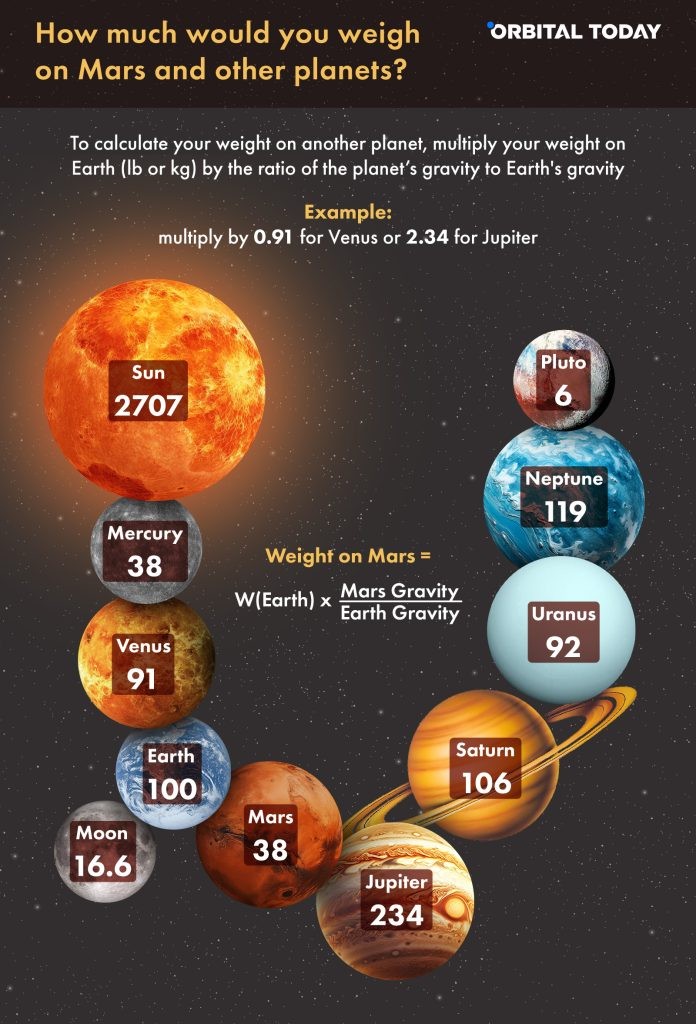Gravity plays a crucial role in shaping planetary environments and influencing the potential for life. With future human missions to Mars on the horizon, understanding Martian gravity is paramount. This article delves into the specifics of gravity on Mars, comparing it to Earth and Venus, and exploring its implications for human exploration.
Understanding Gravity and Surface Gravity
Gravity is the fundamental force of attraction between objects with mass. The strength of this attraction depends on the mass of the objects and the distance between them. Surface gravity, often denoted as ‘g’, represents the acceleration due to gravity at a planet’s surface. On Earth, ‘g’ is approximately 9.8 m/s², meaning objects fall towards the surface with an increasing speed of 9.8 meters per second every second.
Comparing Gravity on Mars, Earth, and Venus
Calculating weight on different planets. Image Credit: orbitaltoday.com
Mars has significantly weaker gravity compared to both Earth and Venus. If Earth’s gravity is considered 100%, then Venus boasts about 91%, while Mars has only around 38%. This means a 200-pound person on Earth would weigh approximately 182 pounds on Venus and a mere 76 pounds on Mars. This difference is primarily due to Mars’s smaller mass and radius compared to Earth and Venus.
Why is Martian Gravity So Weak?
The strength of a planet’s gravity is directly proportional to its mass and inversely proportional to the square of its radius. Mars possesses roughly 11% of Earth’s mass and about half its radius. This smaller mass and radius result in a considerably weaker gravitational pull on the Martian surface.
Falling Faster on Mars?
While Mars’s lower gravity might suggest a slower descent during a fall, the reality is more complex. The thin Martian atmosphere, about 1% as dense as Earth’s, offers minimal air resistance. Consequently, objects falling on Mars would accelerate for longer durations and reach higher terminal velocities compared to falling on Earth.
Walking and Running on Mars
Despite the weaker gravity, walking on Mars is possible. While a person would feel lighter, the weight of spacesuits would likely compensate for the reduced gravitational pull. Theoretically, running on Mars could be faster due to the reduced downward force. However, factors like spacesuit limitations and the Martian terrain covered in dust and rocks would likely pose significant challenges.
Conceptualizing running on Mars. Image Credit: adme.media via orbitaltoday.com
Surviving Martian Gravity: Long-Term Health Concerns
While short-term exposure to Martian gravity isn’t lethal, long-term exposure presents potential health risks. Prolonged periods in low-gravity environments can lead to bone and muscle loss, cardiovascular issues, and vision problems. Future Mars missions will require countermeasures like rigorous exercise regimes and potentially artificial gravity environments to mitigate these risks.
A vision of a future Mars colony. Image Credit: Getty Images/e71lena via orbitaltoday.com
Conclusion
Mars’s gravity, considerably weaker than Earth’s and Venus’s, presents both opportunities and challenges for human exploration. Understanding the implications of this lower gravity, from its effects on movement to its long-term health consequences, is crucial for the success of future Mars missions. Addressing these challenges will require innovative solutions and a deep understanding of human physiology in extraterrestrial environments. Further research into mitigating the negative effects of low gravity is vital to ensure the safety and well-being of future Martian colonists.

